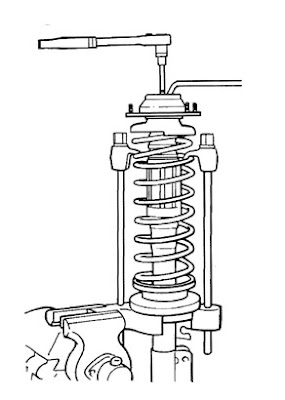
Disc brakes work by pressing two friction brake pads onto a steel disc which is attached to and rotating with the road wheel. The friction caused slows the rotation of the disc and hence of the wheel. Disc brake pads are held within a casting called the calliper, within which two pistons are moved under pressure from brake fluid to push the pads against the disc.
Disc brakes are easy to service (as detailed in Chapter Three), but they are not so easy to repair, and most people seem to opt for exchange reconditioned units rather than tangle with the pistons and seals
themselves. If the pads have less than 0.08 in. of frictional material then they should be exchanged as a set.
Problems with disc brakes include excessive disc run out and general wear and tear, piston seal failure and piston corrosion. We shall deal with each in turn.
Disc run out refers to a condition where the disc is not rotating properly because it is out of balance, perhaps as a result of uneven wear or a knock. Disc run out can be checked at home by placing a fixed item (with a degree of precision) next to the disc, rotating the wheel and noting whether the disc surface remains a constant distance from the object, but it is far better to have this check carried out professionally at any service centre.
Disc wear and tear includes rusting and thinning of the steel disc through usage. scoring of the disc and colouring of the disc because it has overheated. Scoring is obvious to the eye, but in common with the other faults mentioned above, if you suspect that the discs may possess some fault then have them checked professionally.
Replacing brake pads is very quick and easy. Remove the spring clips from the retaining pins, then drift these out using a long parallel punch. Lift away the spring retainer plate, then the pads.
Corroded calliper pistons must be replaced. As the frictional material on the pads wears down, so more and more of the piston emerges from the calliper to take up the 'slack' (disc brakes are therefore self-adjusting). If the pistons are left sticking out from the body of the calliper for any length of time or in the wrong conditions — such as after driving in salty air — then the exposed portion becomes corroded. This condition is most commonly found on cars which have been standing idle for a long lime. Obviously, when new, thicker pads are eventually to be fitted then the pistons have to be firstly pressed back into the callipers; if the piston outer side is corroded then the corrosion destroys the effectiveness of the rubber sealing rings — and the lot has to be replaced.It is possible to renew calliper pistons and seals using the hydraulic system to push out the pistons, although the job is much easier if the callipers are firstly disconnected from the brake hoses and removed from the car.
Remove the pads as already described, then place a clamp on the length of flexible brake hose to minimise fluid loss. Fold back the locking tabs and remove the two hexagon headed bolts which hold the calliper assembly to the stub axle, then remove the flexible hose.
The calliper pistons may be removed by hand, although normally some assistance will be required from a low-pressure compressed air source. A foot pump will suffice, and if a compressor is to be used then turn down the pressure if possible or alternatively, take most of the air from the cylinder until the pressure is no more than 20 psi. If you try to use higher pressure air, the pistons will fly out at great speed! Whether you use a foot pump or a compressor to push out the pistons.












